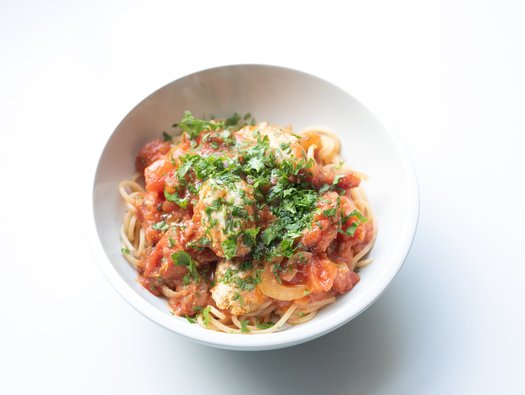Nathan Outlaw’s spaghetti and hake balls

A low salt, full flavoured dish that is low in potassium and phosphate too.

A low salt, full flavoured dish that is low in potassium and phosphate too.
2 tablespoons vegetable oil
2 shallots, peeled and finely chopped
2 garlic cloves, peeled and finely chopped
2 red chillies, deseeded, finely chopped
300g hake fillet, skinned
1 egg, lightly beaten
2 tablespoons flat leaf parsley, finely chopped
1 tablespoon dill, chopped
Black pepper
2 tablespoons olive oil
2 small white onions, peeled and chopped
2 garlic cloves, peeled and chopped
2 sprigs rosemary, leaves picked and chopped
1 teaspoon fennel seeds
1/2 (half) fennel bulb, outer leaves discarded, finely sliced
4 teaspoons sugar
100ml sherry vinegar
700g tinned tomatoes
1 tablespoon parsley leaves, chopped
200g spaghetti
Heat a frying pan over a medium heat and add the vegetable oil, followed by the shallots and garlic. Sweat for two minutes to soften without colouring, then add in the chopped chillies and cook for another minute so the chilli is also softened. Tip out onto a plate and leave to cool.
Check over the hake fillet and remove any bones, then dice the fillet into 2cm cubes. Put the hake fillet in a food processor and blitz for 30 seconds. Scrape down the sides of the food processor, then blend for another 30 seconds. Transfer the fish mixture to a large, cold bowl. Add the cooled shallot mixture and chopped herbs and mix well, then add the beaten egg and freshly ground pepper and stir the mixture thoroughly. Using two teaspoons, make golf ball-sized hake balls and lay them on a tray. Chill them in the fridge while you make the tomato sauce.
Heat a large frying pan or flameproof casserole dish over a medium heat and add the olive oil. When the oil is hot, add the onions and cook for 2-3 minutes until they become translucent. Add the garlic, rosemary and fennel seeds and cook for two minutes. Now add the fennel slices and cook for three minutes. Add the sugar and sherry vinegar and cook for another two minutes. Pour in the tomatoes. Bring to a simmer and then gently cook for 10 minutes.
Gently place the hake balls into the sauce and put the lid of the pan on. Cook over a low heat for 10 minutes.
Cook the spaghetti according to the packet instructions.
To serve, drain the cooked spaghetti and serve into bowls mixed with the tomato sauce and hake balls. Serve immediately with a drizzle of olive oil and a scattering of parsley.
The main source of carbohydrate in this dish is the pasta. Values have been provided for those trained in insulin adjustment.
Hake is a source of phosphate and although in this amount the meal is low in phosphate you may still need to take a phosphate binder if you are prescribed one.
We have reduced the amount of tomatoes and fennel used in this recipe to reduce the potassium content; the recipe is only low potassium if the ingredients are used in the quantities stated.
Hake is a lean source of protein so this recipe is therefore suitable for anyone not following a low protein diet. If you have been advised to reduce your protein intake, you may wish to reduce the amount of hake balls for your serving by half.
You can use another white fish such as cod, haddock or whiting. Mackerel may also be a more cost-effective alternative. This recipe works well with off cuts from fish.
Serve with gluten-free spaghetti.
Consider reducing the sugar by half for a healthier option.
Leftover hake balls and sauce can be kept in the fridge for up to two days, reheat thoroughly and cook pasta to serve. Hake balls can also be frozen individually on a tray with the sauce frozen separately to be served together at a later date.
By giving us your email address, you're giving us permission to send you the latest news from Kidney Care UK. Further information about how we protect and use your personal data is available in our Privacy policy. If you would like to change the way we communicate with you at any time please email [email protected]. You can unsubscribe at any time by using the link at the bottom of every email we send.